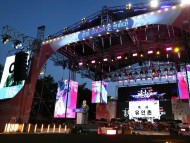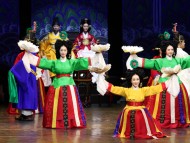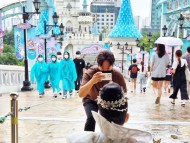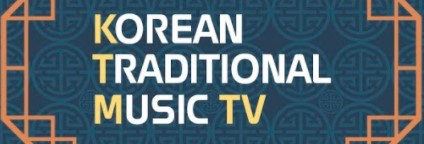2024.05.14 (화)
"International Conference on “Shedding New Light on the Bronze Age in the Honam Region”
- Joint conference to be held by the Naju and Wanju National Research Institutes of Cultural Heritage, and the Society for Korean Bronze Culture, on June 17~18 -
- Michael Lambra
- 등록 2021.06.16 12:22
- 조회수 619

The Naju National Research Institute of Cultural Heritage (chaired by Lee Eun-seok), the Wanju National Research Institute of Cultural Heritage (chaired by Yu Jae-eun), and the Society for Korean Bronze Culture (chaired by Kim Gwon-gu) will jointly hold the international conference titled Shedding New Light on the Bronze Age in the Honam Region at the main lecture hall of the Naju National Research Institute of Cultural Heritage, on June 17 - 18, 2021.
The Honam region (southwestern region of Korea) is an important repository of artifacts dating from the Bronze Age. In particular, the region is home to 22,000 dolmens, the most emblematic relics of the Bronze Age, accounting for around 66% of all dolmens distributed across Korea. This international conference will share the latest research achievements on the Bronze Age in the Honam region with the aim of stimulating further research on Bronze Age culture.
The conference will be held for two days and consist of five chapters comprising oral presentations, video presentations, and a comprehensive discussion.
On the first day (June 17), the first chapter will begin with a keynote lecture by Professor Kim Seung-og (Chonbuk National University) on The Trends and Characteristics of the Bronze Age Culture in the Honam Region and Associated Issues. The rest of the chapter will focus on the Bronze Age culture in the Yeongsangang River basin, with presentations on the following topics: Bronze Age culture in the Yeongsangang River basin (Kim Gyu-joung, Jeonbuk Cultural Property Research Institute); residential distribution patterns of the Bronze Age in the Yeongsangang River basin (Lee Jae-earn, Jeonnam Cultural Property Research Center); and the characteristics and locality of dolmens in the Yeongsangang River basin (Lee Dong-gon, Naju National Research Institute of Cultural Heritage).
The second chapter will focus on the Bronze Age culture in the Mangyeonggang River basin, with presentations on the Bronze Age culture in the Mangyeonggang River basin (Lee Jong-cheol, Chonbuk National University Museum); the residential nature and characteristics of the Bronze Age in the Mangyeonggang River basin (Jeong Da-woon, Wanju County Office); and the current status and characteristics of Bronze Age tombs in the Mangyeonggang River basin (Song A-reum, Buyeo National Research Institute of Cultural Heritage).
The third chapter will focus on the Bronze Age culture in the Seomjingang River and Tamjingang River Basins, with presentations on the development of the Bronze Age culture in the Seomjingang River and Tamjingang River basins (Hwang Jae-hoon, Chungnam National University); residential patterns of the Bronze Age in the Seomjingang River and Tamjingang River basins (Kim Jin-hwan, Haewon Cultural Heritage Research Institute); and the characteristics and locality of dolmens in the Seomjingang River and Tamjingang River basins (Kang Dong-seok, National Research Institute of Cultural Heritage).
On the second day (June 18), the fourth chapter will focus on the Honam region’s early Iron Age culture, with presentations on the early Iron Age culture in the Honam region (Han Su-young, Honam Cultural Property Research Center); dwellings and graves of the early Iron Age culture in the Jeollanam-do region (Kim Jin-young, Ancient Cultural Property Research Institute); and the characteristics and locality of relics of the early Iron Age culture in the Jeollabuk-do region (Jung Su-ock, Cultural Heritage Administration).
The fifth and final chapter will consist of the following video presentations on the theme of agriculture of the Bronze Age in China, Japan, and the Honam region: the origins of rice cultivation based on Chinese archaeology studies and changes in the perception of Chinese civilization (Zheng Yun Fei, Zhejiang Civilization and Archaeology Research Institute, China); and the Bronze Age culture in Japan and the Honam region (Miyazato Osamu, Kochi University, Japan).
The presentations will be followed by a comprehensive discussion based on the fifteen subjects presented at the conference. The discussion will be chaired by Professor Lee Chung-kyu of Yeungnam University, with the participation of Yun Ho-pil (Sangju Museum), Cheon Seon-haeng (Jeolla Cultural Heritage Research Institute), Lee Dong-hee (Inje University), Jo Jin-seon (Chonnam National University) and Kim Gwon-gu (Keimyung University).
In order to prevent the spread of COVID-19, the number of attendees at the conference will be limited to a maximum of 50 persons with advance reservations. The contents of the conference will be streamed live on the YouTube channel of the National Research Institute of Cultural Heritage. To ensure that the conference proceeds smoothly, the organizers will observe the COVID-19 prevention guidelines by disinfecting the venue, checking the body temperature of the attendees, installing hand sanitizers, insisting on the use of masks, and assigning a specific seat to each participant.
* YouTube channel of the National Research Institute of Cultural Heritage: https://www.youtube.com/watch?v=1_Yx4eJEZ2E
The Naju National Research Institute of Cultural Heritage and the Wanju National Research Institute of Cultural Heritage plan to organize diverse events in the future to allow domestic and international researchers to discuss the Bronze Age culture from a wide range of perspectives and share research achievements with academic circles and the general public.
- [] 제17회 대한민국 서봉판소리·민요대제전 (06/02)
- [] 제6회 울진금강송 전국국악경연대회(06/08)
- [] 제29회 대통령상 한밭국악전국대회(07/06-07) (무용/기악/성악)
- [] 제8회 목담 최승희 전국국악경연대회(06/01) (판소리,기악)
- [] [서울]제28회 전국판소리경연대회(06/15-16)
- [] 제32회 대전전국국악경연대회(06/01-02)
- [] 제16회 순천 낙안읍성 전국가야금병창경연대회(05/25-26)
- [] 제18회증평국악경연대회(05/11)
- [] [군산]제32회 전국청소년민속예술경연대회(05/18)
- [] 제42회 전주대사습놀이 학생전국대회(5/18∼6/2)
- [] 제50회 전주대사습놀이 전국대회(5/18~6/3)
- [] 제20회 전국대금경연대회(06/08-09)
- [] 제4회 함양 전국국악경연대회(05/12)
- [] 제18회 대한민국 전통예술무용·연희대제전(06/09)<br>무용(전통무용…
- [] 제48회 부산동래 전국전통예술경연대회(06/15-16)(무용.기악)
- [] [광주]제21회 대한민국 가야금병창대제전(06/16)
- 제11회 곡성 통일전국종합예술대전(06/15-16)(판소리.무용, 기악,…
- [] 제24회 인천국악대제전 전국국악경연대회(05/25-26)
- [] 제26회 창원야철전국국악대전(07/06- 07)
- [] 2024 무안장애인 승달국악대제전(06/01-02)
- [] 제22회 무안전국승달국악대제전(06/01-02)
- [] 제10회 전국공주아리랑민요경창대회(05/26)
- [] 제17회 상주전국국악경연대회(05/19)(성악/무용·연희/기악)
- [] 제10회 전국밀양아리랑경창대회(05/26)
- [] 제21회 강남전국국악경연대회(05/22)(무용/타악/판소리/민요)
- [] 제29회 안산전국청소년국악경연대회(05/26)
- [] 제26회(통합58회) 여수진남전국국악경연대회(05/18-19)
- [] 제23회 대한민국 빛고을 기악대제전(05/25-26)
- [] [인천] 제10회 계양산국악제(04/26-27) (풍물,사물, 기악,민요…
-

[월요연재] 이윤선의 남도문화 기행(145)<br>한국 최초 '도깨비 학회', 아·태…
아시아태평양 도깨비 몇 마리 도깨비학회 슬로건 '이론과 실천'| 실천 앞세우지 않는 이론은 한여름 밤의 꿈일 뿐이요 이론 전제하지 않는 실천은 망나니의 칼춤일 뿐이다 어둠 ...
-

[화요연재] 무세중과 전위예술(11) <BR>민족 극단, 출발(出發)과 시안(試案)
劇団 民族 代表 金世中, 1971년 연극을 조금씩 알면서부터 내가 내한 연극에 대한 나의 입장을 밝히는 것 이 큰 문제거리었다....
-

[금요연재] 도자의 여로 (144) <br>분청사기마상배편
이 작은 감동과 즐거움만이라도 이규진(편고재 주인) 도자기 중에는 마상배(馬上杯)라는 것이 있다. 별도의 굽 없이 곧게 선 긴 다리가 몸체로 연결되는 팽이 모양의 ...
-

[수요연재] 이무성 화백의 춤새(90)<br> 춤꾼 송영은의 '강선영류 태평무' 춤사…
태평무 국가무형유산 '태평무'는 강선영(1925-2016)선생에 의해 전해지면서 격조있는 무대예술로 발전 되었다. 태평무는 나라의 풍년과 태평성대를 축원하는 뜻을 지니...
-

[Pick리뷰] 앙상블 시나위가 그려내는 ‘고요의 바다’
[국악신문 정수현 전문기자]=봄 향기가 가득한 5월의 첫날, 전통음악을 바탕으로 우리 정서를 찾아 나서는 앙상블 시나위의 콘서트 ‘고요의 바다’가 세종문화회관 M씨어터에서 펼쳐졌다...
-

[기자의 객석] 원장현과 이태백 긴산조 협주곡, “보셨습니까?”
국립국악원 창작악단 기획공연 '긴산조 협주곡' 무대에 오른 원장현 명인의 모습. (사진=국립국악원 창작악단) 2023.05.03. ...
-

[PICK인터뷰] 원장현 명인, “산조는 우리 삶의 소리”
[국악신문 정수현 전문기자]=국립국악원 창작악단은 오는 5월 9일과 10일 국립국악원 예악당에서 이태백류 아쟁산조와 원장현류 대금산조 전바탕 '긴산조 협주곡'을 초연한다. 아쟁과 ...
-

[Pick리뷰] 경성 모던걸들의 춤판 '모던정동'…"자유 갈망하는 모습 담아"
30일 서울 중구 국립정동극장에서 열린 국립정동극장예술단 정기공연 '모던정동' 프레스콜에서 출연진이 주요 장면을 시연하고 있다. 2024.4.30 ...
-

세실풍류, 박병천의 '구음시나위'에 허튼춤 선사한 안덕기
국립정동극장이 4월 한달간 진행하는 '세실풍류 : 법고창신, 근현대춤 100년의 여정'에서 23일 박병천의 '구음시나위'에 허튼춤 추는 안덕기 (사진=국립정...
-

세실풍류, 동해별신굿 민속춤사위를 제해석한 조재혁의 '현~'
국립정동극장이 4월 한달간 진행하는 '세실풍류 : 법고창신, 근현대춤 100년의 여정' 에서 조재혁의 '현~' 공연 모습. (사진=국립정동극장). 2024....
-

[Pick리뷰] 이호연의 경기소리 숨, ‘절창 정선아리랑!’
# ‘이호연의 경기소리 숨’ 공연이 지난 4월 26일 삼성동 민속극장 ‘풍류’에서 열렸다. 20대에서 60대까지의 제자들 20명과 5명의 반주자와 함께 경기잡가, 경기민요, 강원도...
-

[PICK인터뷰] 미리 만나 보는 '제94회 남원춘향대전'
[국악신문 정수현 전문기자]=대한민국에서 가장 오래된 축제로 손꼽히는 남원춘향대전(남원춘향제)이 오는 5월 10일(금)부터 5월 16일(목)까지 7일간 남원시 광한루원 일대에서 열...
-

[Pick리뷰] 모던연희극 ‘新칠우쟁론기’
4월 18일부터 20일, 남산국악당에서 아트플랫폼 동화의 모던연희극 ‘新칠우쟁론기’가 펼쳐졌다. [국악신문 정수현 전문기자]=지...
-

[PICK인터뷰] 국립국악관현악단의 채치성 예술감독을 만나다
[국악신문 정수현 전문기자]=봄비가 촉촉이 땅을 적시는 4월, 국립국악관현악단 예술감독으로 취임한 지 6개월이 된 채치성 예술감독님을 만났다. 그는 국악방송 사장, KBS 국악관현...






























